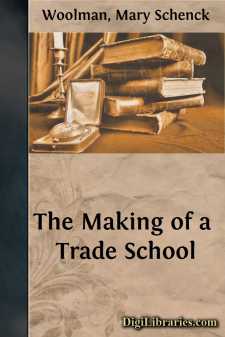Categories
- Antiques & Collectibles 13
- Architecture 36
- Art 48
- Bibles 22
- Biography & Autobiography 813
- Body, Mind & Spirit 142
- Business & Economics 28
- Children's Books 15
- Children's Fiction 12
- Computers 4
- Cooking 94
- Crafts & Hobbies 4
- Drama 346
- Education 46
- Family & Relationships 57
- Fiction 11828
- Games 19
- Gardening 17
- Health & Fitness 34
- History 1377
- House & Home 1
- Humor 147
- Juvenile Fiction 1873
- Juvenile Nonfiction 202
- Language Arts & Disciplines 88
- Law 16
- Literary Collections 686
- Literary Criticism 179
- Mathematics 13
- Medical 41
- Music 40
- Nature 179
- Non-Classifiable 1768
- Performing Arts 7
- Periodicals 1453
- Philosophy 64
- Photography 2
- Poetry 896
- Political Science 203
- Psychology 42
- Reference 154
- Religion 513
- Science 126
- Self-Help 84
- Social Science 81
- Sports & Recreation 34
- Study Aids 3
- Technology & Engineering 59
- Transportation 23
- Travel 463
- True Crime 29
The Making of a Trade School
Categories:
Description:
Excerpt
ORGANIZATION AND WORK
History
The Manhattan Trade School for Girls began its work in November, 1902. The building selected for the school was a large private house at 233 West 14th Street, which was equipped like a factory and could comfortably accommodate 100 pupils. Training was offered in a variety of satisfactory trades which required the expert use of the needle, the paste brush, and the foot and electric power sewing machines.
Beginning with twenty pupils on its first day, it was but a few months before the full 100 were on roll and others were applying. In endeavoring to help all who desired instruction the building was soon overcrowded. It thus became evident that, unless increased accommodation was provided, the number already in attendance must be decreased and others, anxious for the training, must be turned away. It was decided that even though the enterprise was young the need was urgent, demanding unusual exertion. It would therefore be wise to make every effort to purchase more commodious quarters. In June, 1906, the school moved to a fine business building at 209-213 East 23d Street, which could offer daily instruction to about 500 girls.
The movement owes its existence to the earnest study that a group of women and men, interested in philanthropic, sociological, economic, and educational work, gave to the condition of the working girl in New York City. They were all intimately acquainted with the difficulties of the situation. Early in the winter of 1902 this committee made a special investigation of the workrooms of New York. They were but the more convinced that (1) the wages of unskilled labor are declining; (2) while there is a good opportunity for highly skilled labor, the supply is inadequate; (3) the condition of the young, inexpert working girl must be ameliorated by the speedy opening of a trade school for those who have reached the age to obtain working papers; (4) if public instruction could not immediately undertake the organization of such a school, then private initiative must do it, even though it must depend for its support upon voluntary contributions. The result was that an extreme effort was put forth and the following November the first trade school in America, for girls of fourteen years of age, was begun.
The first Board of Administrators, composed largely of members of the original committee of investigators, was as follows:
President, Miss Virginia Potter; Vice-Presidents, Dr. Felix Adler, Mr. John Graham Brooks, Mrs. Theodore Hellman, Mrs. Anna Garlin Spencer, Mrs. Henry Ollesheimer; Treasurer, Mr. J. G. Phelps Stokes; Secretary, Mr. John L. Eliot; Assistant Secretary, Miss Louise B. Lockwood; Director, Professor Mary Schenck Woolman.
The immediate purpose of the school was to train the youngest and poorest wage-earners to be self-supporting as quickly as possible. It was decided to help the industrial workers rather than the commercial and professional, as the last two are already to some extent provided for in education....


